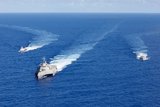Cobham demonstrates interference resistant antennas
Cobham Antenna Systems has announced that in collaboration with Seasat of Denmark, it has successfully demonstrated its L band interference resistant Sea Tel 9797B and Sea Tel 4009M marine stabilised antenna systems operating in the X band and Ku band radio frequency spectrum, respectively. Cobham made the announcement in a 13 March 2012 company statement.
The antenna systems have been purchased by the Danish Defence Acquisition and Logistics Organization (DALO). These systems are designed such that spurious signals are attenuated by a minimum of - 60dBc and in this way complying with the applicable NATO Standard.
According to Cobham, the L band frequencies have become standard for communication between the indoor equipment and antenna systems on board. Many navies have also installed radars operating in the same frequency range. This creates the potential for significant interference for both navies and commercial ships operating in the arena. The interference can manifest itself as rebroadcast, swamping the satellite and interfering with other users, and as direct interference to the onboard communications system.
Fred Cahill, vice president of Cobham Antenna Systems, said, ‘The Danish Navy has been a loyal end-user of Sea Tel products and are dealing with a unique challenge that they brought to our attention. The distinctive combination of Cobham’s unrivalled expertise in building the most advanced marine stabilized antenna systems together with Seasat’s undoubted leadership in the Danish market, have come together to solve this tricky problem for the Danish Navy. This is an exciting development, in particular because it allows navies around the world to continue the use of their L band radars without the dangers of spurious signals and interference to others.’
Sea Tel 9797B and 4009M systems were specifically designed to meet DALO’s requirements of protection against a field strength of 100 V/m to mitigate the possibility of transmitting spurious signals to the satellite. In collaboration with Seasat and DALO, Cobham used Zone Isolation Methodology (ZIM) to eliminate or reduce spurious noise at the point origination, mostly interconnections. The interconnection zones include various electrical and electronic components in the antenna system.
More from Digital Battlespace
-
![Babcock nears first customer for Nomad AI translation tool]()
Babcock nears first customer for Nomad AI translation tool
Nomad can provide militaries with real-time intelligence, saving critical time on the battlefield.
-
![AUSA 2025: Israel’s Asio Technologies to supply hundreds of improved Taurus tactical systems]()
AUSA 2025: Israel’s Asio Technologies to supply hundreds of improved Taurus tactical systems
Taurus operates alongside the Israel Defense Forces’ Orion system which supports mission management across tens of thousands of manoeuvring forces, from squad leaders to battalion commanders.
-
![AUSA 2025: Kopin pushes micro-LED plans as China moves faster]()
AUSA 2025: Kopin pushes micro-LED plans as China moves faster
The plan for the new displays follows fresh investment in Kopin’s European facilities by Theon and an order for head-up displays in fielded aircraft, with funding from the US Department of Defense.
-
![AUSA 2025: Persistent Systems to complete its largest order by year’s end]()
AUSA 2025: Persistent Systems to complete its largest order by year’s end
Persistent Systems received its largest ever single order for its MPU5 devices and other systems earlier this month and has already delivered the 50 units to the US Army’s 4th Infantry Division.
-
![Aselsan brings in dozens of companies and systems under the Steel Dome umbrella]()
Aselsan brings in dozens of companies and systems under the Steel Dome umbrella
Turkey has joined the family of countries attempting to establish a multilayered air defence system with government approval in August 2024 for the effort landed by Aselsan. Dubbed Steel Dome, the programme joins Israel’s Iron Dome, the US Golden Dome, India’s Mission Sudarshan Chakra and South Korea’s low-altitude missile defence system.
-
![DSEI 2025: MARSS unveils new agnostic multidomain C4 system]()
DSEI 2025: MARSS unveils new agnostic multidomain C4 system
MARSS’ NiDAR system has been deployed using sensors from static platforms to provide detection and protection for static sights, such as critical infrastructure, ports and military bases.




























